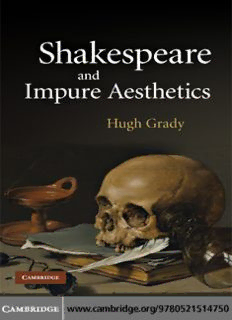
Shakespeare and Impure Aesthetics PDF
Preview Shakespeare and Impure Aesthetics
This page intentionally left blank SHAkESPEArE And ImPUrE AESTHETIcS Shakespeare and Impure Aesthetics explores ideas about art implicit in Shakespeare’s plays and defines specific Shakespearean aesthetic practices in his use of desire, death, and mourning as resources for art. Hugh Grady draws on a tradition of aesthetic theorists who understand art as always formed in a specific historical moment but as also distanced from its context through its form and utopian pro- jections. Grady sees A Midsummer Night’s Dream, Timon of Athens, Hamlet, and Romeo and Juliet as displaying these qualities, show- ing aesthetic theory’s usefulness for close readings of the plays. The book argues that such social-minded ‘impure aesthetics’ can revital- ize the political impulses of the new historicism while opening up a new aesthetic dimension in the current discussion of Shakespeare. hugh grady is Professor of English at Arcadia University in Glenside, Pennsylvania. He is the author of The Modernist Shakespeare: Critical Texts in a Material World (1991), Shakespeare’s Universal Wolf: Studies in Early Modern Reification (1996) and Shakespeare, Machiavelli and Montaigne: Power and Subjectivity from Richard II to Hamlet (2002). He is editor of Shakespeare and Modernity: From Early Modern to Millennium (2000) and co-editor (with Terence Hawkes) of Presentist Shakespeares (2007). SHAkESPEArE And ImPUrE AESTHETIcS HUGH Gr Ady CAMBRIDGE UNIVERSITY PRESS Cambridge, New York, Melbourne, Madrid, Cape Town, Singapore, São Paulo, Delhi, Dubai, Tokyo Cambridge University Press The Edinburgh Building, Cambridge CB2 8RU, UK Published in the United States of America by Cambridge University Press, New York www.cambridge.org Information on this title: www.cambridge.org/9780521514750 © Hugh Grady 2009 This publication is in copyright. Subject to statutory exception and to the provision of relevant collective licensing agreements, no reproduction of any part may take place without the written permission of Cambridge University Press. First published in print format 2009 ISBN-13 978-0-511-60497-3 eBook (NetLibrary) ISBN-13 978-0-521-51475-0 Hardback Cambridge University Press has no responsibility for the persistence or accuracy of urls for external or third-party internet websites referred to in this publication, and does not guarantee that any content on such websites is, or will remain, accurate or appropriate. To Constance Claire Grady The first in time and the first in importance of the influences upon the mind is that of nature. Every day, the sun; and after sunset, Night and her stars. Ever the winds blow; ever the grass grows. Every day, men and women, conversing – beholding and beholden. The scholar is [s]he of all men [and women] whom this spectacle most engages. Ralph Waldo Emerson, ‘The American Scholar’ Contents Acknowledgements page viii 1 Introduction: impure aesthetics 1 part One a s hakespearean aesthetic: intO the WOOds Outside athens 45 2 A Midsummer Night’s Dream – eros and the aesthetic 47 3 modernity, usury, and art in Timon of Athens 90 part tWO the aesthetics Of death and mOurning 131 4 Hamlet as mourning-play 133 The aesthetics of the trauerspiel 133 Hamlet as Trauerspiel 154 Post-script: Hamlet, subjectivity, and aesthetics 187 5 Beautiful death in Romeo and Juliet 193 conclusion: the critical present 225 Bibliography 240 Index 257 vii Acknowledgements my first debt is to my wife and intellectual partner, Susan Wells, who has shared the passion for politics, family, art, and nature which has sus- tained both of us for our adult lives and to which this book bears witness. We have shared, discussed, and debated the issues of this book over many decades. I want to thank also the other two members of a small reading circle of Theodor Adorno’s Aesthetic Theory in 2004–2005 – rachel duPlessis of Temple University and mary Hawkesworth of rutgers, without whose insights my study of Adorno would have been both slower and more labored. my thanks also to readers of individual manuscript chapters who gave me valuable comments and encouragement: Susan Wells, Terence Hawkes, charles Whitney, kathleen mcLuskie, Philip Alperson, david Hawkes, Avi Oz, and Ewan Fernie. The book has also benefited from conversations and emails with many interested scholars and critics over the years of its gestation: my thanks especially for this stimulation go to John Joughin, madalina nicolaescu, Terence Hawkes, david Hawkes, dick Wertime, and John drakakis. I am grateful for specific information and commentary on some issues supplied by dan Traister, christopher norris, Lynne Bruckner, Ewan Fernie, don Hedrick, Sharon O’dair, Stephen cohen, Simon Jarvis, and Heather duBrow. The final versions of chapters 2 and 4 were shaped in part in response to comments by readers for the journals Shakespeare Studies and Shakespeare Quarterly, which each published a compacted version of one of these chapters. chapter 3 on Timon of Athens is a revised, expanded, and re-con textualized version of an earlier essay on the play in richard dutton and Jean Howard (eds.), A Companion to Shakespeare’s Works, Vol. i: The Tragedies (Oxford: Blackwell, 2003). The final draft responds to the astute comments of two anonymous readers for cambridge University Press. viii
Description: